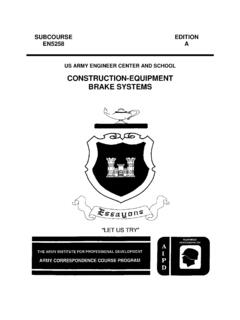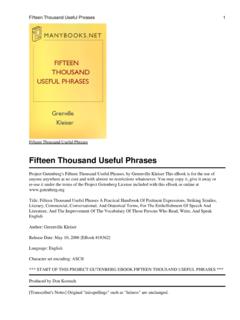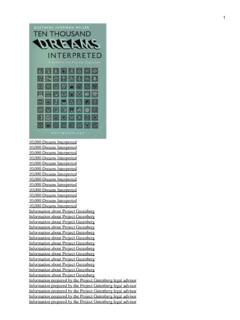Transcription of Basic Schematic Interpretation
1 SUBCOURSE EDITION OD1725 B Basic Schematic Interpretation Basic Schematic Interpretation Subcourse Number OD1725 Edition B March 1996 United States Army Ordnance Center and School 5 Credit Hours SUBCOURSE OVERVIEW This subcourse presents Basic Schematic Interpretation in three parts. Part A identifies Basic symbols used in circuit schematics . Part B discusses typical component characteristics and their functional use within a circuit. Part C describes the methods to determine reference designators and the procedures for wire tracing in a circuit. Part C also includes a wire tracing exercise. Terminal Learning Objective Actions: You will recognize the various symbols used in Schematic diagrams of Army technical manuals. You will understand their characteristics and how they function in typical circuit applications.
2 You will also perform wire tracing in a practical wire tracing exercise using extracts from an Army technical manual. Conditions: You will be given the subcourse booklet with extracts from TM 9-5855-267-24. Standards: You will perform wire tracing procedures in accordance with TM 9-5855-267-24. There are no prerequisites for this subcourse. The following publications are the references for this subcourse: FM 11-60 Basic Principles, Direct Current, November 1982. FM 11-61 Basic Principles, Alternating Current, November 1982. i OD1725 FM 11-62 Solid State Devices and Solid State Power Supplies, September 1983. FM 11-72 Digital Computers, September 1977. TM 9-5855-267-24 Sight, Tank Thermal AN/VSG-2, December 1980.
3 ANSI Graphic Symbols for Electrical and Electronics Diagrams, October 1975. This subcourse contains information which was current at the time it was prepared. In your own work situation, always refer to the latest publications. The words "he," "him," "his," and "men," when used in this publication, represent both the masculine and feminine genders unless otherwise stated. ii OD1725 TABLE OF CONTENTS Section Page Subcourse Overview .. i Lesson: Basic Schematic Interpretation .. 1 Part A: Identification of Electrical and Electronic Schematic Symbols .. 2 Part B: Component Characteristics and Functional Use .. 22 Part C: Wire Tracing.
4 30 Practice Exercise .. 36 Answer Key and Feedback .. 38 Appendix A: List of Acronyms and Abbreviations .. 49 Appendix B: List of Designation Letters .. 51 Appendix C: Extracts from TM 9-5855-267-24 .. 53 iii OD1725 CONTINUE TO THE NEXT PAGE. iv OD1725 LESSON Basic Schematic Interpretation LEARNING OBJECTIVE Actions: a. Identify the symbols used in typical Schematic diagrams of Army technical manuals. b. Describe the characteristics and circuit functions of electrical and electronic components used in Army fire control instruments. c. Wire trace a circuit using the procedures specified in an Army technical manual.
5 Conditions: You will be given the subcourse booklet with extracts from TM 9-5855-267-24. Standards: You will perform the wire tracing procedures in accordance with TM 9-5855-267-24. introduction One of the essential elements of an effective unit is the ability to effectively repair malfunctioning equipment and return it to service quickly. For the fire control systems repairer (MOS 45G), this often means the adjustment, replacement, or repair of the electrical and electronic components within the fire control instruments and their associated test equipment. In order for the technician to understand the operation of the equipment and the procedures for troubleshooting and repair, he must be able to identify components and understand how they function within that particular circuit.
6 He must also be able to trace signals through and between circuits. This lesson identifies typical symbols used in Army technical manuals for electrical and electronic systems. It describes their functional operation in circuit application. It also provides an exercise in wire tracing, using the procedures specified by TM 9-5855-267-24. 1 OD1725 PART A - IDENTIFICATION OF ELECTRICAL AND ELECTRONIC Schematic SYMBOLS In order to understand the functioning of an electrical or electronic circuit, you must be able to "read" the Schematic diagram of that circuit. A Schematic diagram is the road map of the circuit. In order to get from one point to another, you must be able to follow the appropriate route and understand the meanings of the various symbols found along the way.
7 1. Symbols. Just as the road map uses symbols to represent the highways, cities, interchanges, and other elements displayed, the Schematic diagram uses symbols to represent the components used to make up a circuit. Symbols are used to indicate conductors, resistors, switches, motors, transistors, and other electrical and electronic parts. Components in a circuit Schematic are generally represented by such a symbol and/or a letter designator. This part of the lesson reviews many of the symbols used by Army technical manuals in the Schematic diagrams of the appropriate equipment. 2. Conductors. Basic to any Schematic diagram is the use of straight lines to indicate conductors. The conductor is the "roadway" of the circuit map.
8 The conductors interconnect the components of the circuit. Conductors often cross paths with one another in the circuit. This may occur with or without their making electrical contact. Figure 1-1 illustrates the typical methods for crossing conductors within a Schematic diagram. Figure 1-1. Crossing Conductors. There are many types of conductors used in electrical and electronic circuits. They may range from the thin layers of metal foil used in printed-circuit boards to heavy cables used in power transmission. Cables generally consist of two or more conductors, usually in the same insulation jacket. A special type of conductor found in many electronic applications is the shielded wire or coaxial cable. Here, the conductor is 2 OD1725 surrounded by a metallic shield to protect against interference from adjacent electrical influence.
9 The shielding on the cable may or may not be grounded. Figure 1-2 shows some common symbols for shielded conductors. Figure 1-2. Shielded Conductors. 3. Basic Components. There are literally hundreds of different types of electrical and electronic components in use today. However, three components are widely used in a wide variety of applications. These three components are found in most circuit schematics of any complexity. The three components are (a) resistors; (b) capacitors; and (c) inductors. a. Resistors. Resistors are unquestionably the most commonly used circuit components. They are found in almost every electrical and electronic Schematic diagram. Resistors are appropriately named in that they are designed to "resist" the flow of electrical current.
10 Resistors are typically shown in schematics by the symbol illustrated in figure 1-3. Figure 1-3. Fixed Resistors. In addition to the symbol, the resistor is generally labeled by the letter "R" followed by a number, , R1, R2, etc. The resistance value, measured in ohms, may also be indicated. If the resistance is not indicated, you can determine it by 3 OD1725 observing the color coding used on most resistors. Figure 1-4 lists the color-coded values used in marking carbon resistors. Figure 1-4. Color Code for Resistors. Several variations of resistors exist. The symbol shown in figure 1-3 is that of a fixed resistor, one of a set or fixed value. Resistors also may have variable values of resistance. This may be achieved by the use of variable resistors that may be adjusted, or through the use of tapped resistors which have two or more selected values of resistance.














